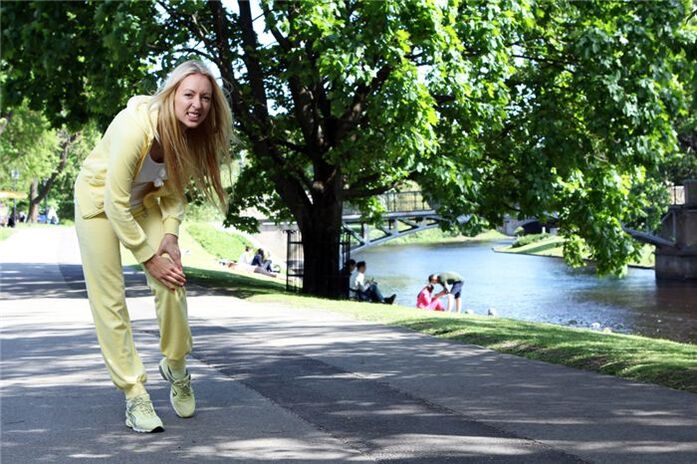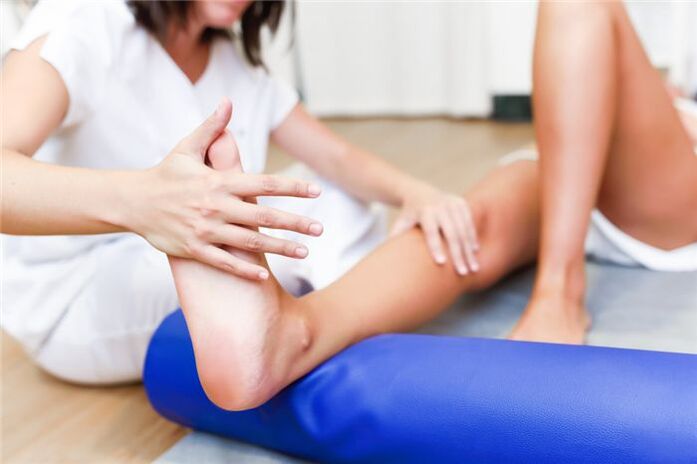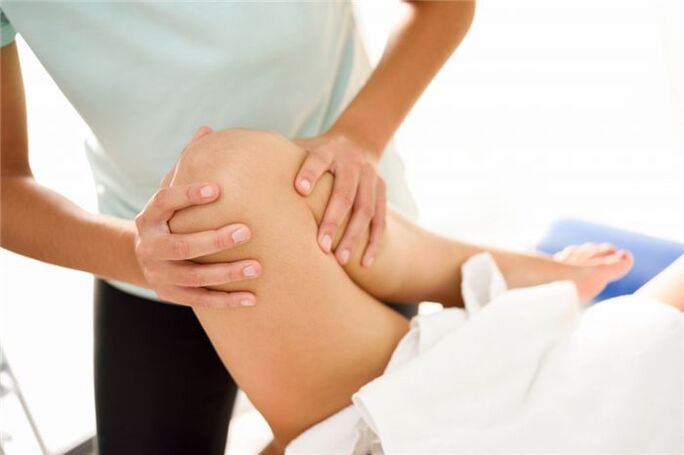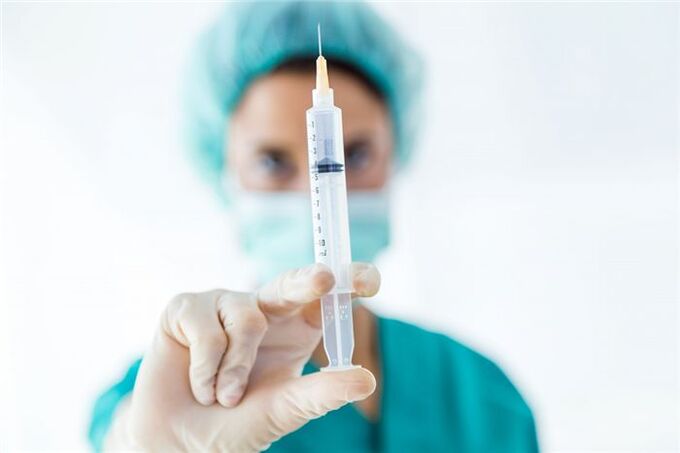knee joint diseaseis a degenerative dystrophic disease of cartilage tissue that results in exposed bones and impaired joint mobility. The disease is non-inflammatory and progresses slowly - the transition from initial stage to disability takes years to decades. Knee osteoarthritis is one of the top 5 causes of disability and disability worldwide.
Osteoarthritis of the knee (knee joint disease) affects more than 20% of people over the age of 55, but the disease is rapidly becoming younger - with symptoms increasingly appearing at age 25.

Prompt treatment of knee arthropathy will help avoid complications and destruction of cartilage tissue.
Signs of knee osteoarthritis
The wear of articular cartilage is accompanied by characteristic signs, the intensity of which depends on the stage of the disease.In most cases, patients complain of:
- Morning stiffness and reduced joint mobility (wake up to warm up);
- Knee pain and discomfort that worsens with physical exertion (long walking, running, or standing) and lessens with rest;
- In the second stage - so called. Pain starts after holding one position for a long time;
- increased fatigue, which is often attributed to age-related changes;
- A clean crunch, repeated regularly as you bend and straighten your knee;
- Edema and other symptoms of inflammation in the second stage of the disease due to trauma to the tissues around the joint;
- Meteorological sensitivity, worsening symptoms in cold season.
When trying to bend a knee that is affected by knee arthropathy to a stop, there is a feeling of severe pain and physical disability. Even after treatment of knee joint disease, the patient's gait is unsteady (staggering gait, leg stiffness), and lower limb deformities are manifested by the letter "O" or "X" ".
The insidious nature of the disease is that it can lie dormant for many years, and the first noticeable symptoms usually appear only in the second stage - when full recovery of the synovial cartilage is no longer possible.
Therefore, it is important to see a doctor at the first sign of discomfort in the knee—for example, weakness, as if a pulling pain occurs when synovial fluid production is insufficient. Remember: Knee pain is not normal regardless of age. Prompt examination and treatment of 1st degree knee arthropathy can completely protect you from severe pain in the elderly joints.
What happens if knee osteoarthritis is not treated?
Osteoarthritis of the knee progresses on average 3-8 times faster than complex treatments when self-medicated, not prescribed, or not treated. If arthropathy progresses severely, patients may lose their ability to perform normal activities even before retirement age begins.
Of particular importance is the effective treatment of knee arthropathy in the acute phase. It can be caused by wet and cold weather, physical or emotional stress, allergies, poisoning, moving to a region with a different climate — in short, any change in the body. Arthropathy worsens with the destruction of a large number of chondrocytes. In response, the body produces enzymes designed to process and remove dead cells. However, if their concentrations are too high, healthy areas of the cartilage can also be affected - cell membranes thin and foci of erosion appear in the lining of the joint synovium. If the process is not stopped with medication for knee joint disease, it can last for several weeks, and it can be permanent in the case of chronic stress, lack of sleep, or poor diet.
Ultimately, without treatment, knee osteoarthritis can lead to complete reduction of the joint space lumen due to the growth of osteophytes. The gap required for normal movement is closed and the patient cannot even bend the leg 30-45°. The difficulty is not only in climbing stairs, but also in trying to get up from the couch or exercise normally. This condition is accompanied by pain, which conventional pain relievers will not help with. In this case, there is only one option for the treatment of knee arthropathy - surgery, which is the complete replacement of the joint structure with a prosthesis and subsequent long-term rehabilitation. But even in this situation, most patients are unable to return to a completely normal life.
Treatment of knee osteoarthritis
Arthropathy of the knee is treated conservatively or surgically, depending on the stage of the disease and the condition of the joint.
Treatment of first-degree knee arthropathy is always conservative - a successful combination of the environment and the patient's good self-discipline has the potential to achieve a cure or stable remission of the disease.
Treatment of 2nd-degree knee arthropathy is usually based on the use of all conservative treatments, however, if the disease progresses severely or is accompanied by complications, the doctor may decide to perform minor surgical intervention on the joint.
Treatment of grade 3 knee osteoarthritis almost always involves surgery.
Comprehensive conservative management of knee arthropathy includes eliminating pain and inflammation, restoring cartilage tissue, and increasing joint range of motion. For this, patients are prescribed an orthopedic regimen of stress and rest, drugs of systemic and local action (hormonal and non-hormonal anti-inflammatory drugs, analgesics, chondroprotective agents, etc. ). Innovative biological approaches are also gaining popularity - direct injection of drugs for knee arthropathy into the joint pocket. In this case, PRP injections (platelet-rich plasma) are used, as well as stem cells obtained from the patient's own adipose tissue. At the same time, assistive and rehabilitative methods are interlinked - physiotherapy, massage, manual therapy, therapeutic exercises.
Surgical treatment of knee osteoarthritis in the absence of medication.For this pathology, doctors may prescribe the following interventions:
- Knee arthroscopy. A collective term for a group of minimally invasive procedures designed to remove fragments of joint tissue or osteophytes, or partial excision of the joint membrane. It allows you to delay or exclude prosthetics and eliminate discomfort in the early stages of the disease. Mainly used to treat knee joint disease in patients under 60 years old.
- Osteotomy. A procedure that cuts part of the bone and corrects the load axis on the affected knee, which allows you to slow down degenerative changes. It is commonly used to treat second-degree arthropathy of the knee.
- Built-in prosthesis. Partial or complete replacement of the knee joint with titanium implants for 15-20 years. This technique is a last resort as it carries certain risks. Recommended for patients over 55 years of age.
All of these surgeries require a recovery period and have many contraindications, so the best options are early prevention (exercise therapy, chondroprotective agents) and treatment of knee joint disease.
In addition to the main treatments, there are diet regimens and other ways to lose weight. To unload the diseased joint, bandages and other orthoses (canes, orthopedic insoles, etc. ) are used.
Treatment for knee joint disease is prescribed by a rheumatologist or orthopedic surgeon. At the first appointment, he will palpate the joint, perform a movement test, and then instruct the patient on a tomography or X-ray.
Therapeutic Exercises for Knee Arthropathy
Therapeutic exercises with a lower extremity girdle are considered the most effective way to relieve first-degree knee pain and treat arthropathy. After 2-4 weeks of continuous training, the first results of therapeutic exercises appeared. The continuity of treatment of knee joint disease is one of the main factors affecting the effect of exercise treatment. Do 1 full session a day and also recommend at least 3-4 workouts during the day.

Therapeutic exercises for knee joint disease during remission will help relieve pain.
The main tasks of physical exercise in the treatment of knee osteoarthritis are to strengthen the muscles of the thigh and calf, maintain the elasticity of the ligaments and tendons, and combat the muscle wasting that characterizes the arthropathy. This allows you to transfer the load from the joint to the surrounding structures - thereby slowing the mechanical wear of the cartilage and reducing inflammation.
Exercises for the treatment of knee joint disease on both legs! If severe pain occurs, the training should be stopped or continued at a more gentle pace.
- Starting position - Lie on your back. Extend one leg on the floor and bend the other leg up 90° (calf parallel to the floor). We use the calf to move up and down as long as the range of motion of the joint allows.
- Starting position - Lie on your back. Let's do cycling.
- Starting position - prone. We take turns swinging our legs, trying to keep our heels as close to our hips as possible.
- Starting position - Lie on your side with your arms bent under your head or in line with your body above your head. Put the other hand aside. We swing up with straight legs. We switch sides.
- Starting position - Lie on your back. We pull the leg forward along the floor with the heel (away from you) and the sock looks "looking at itself".
- Starting position - prone. We do the "boat" exercise. If physical fitness does not allow, we place the palms on the sides of the chest, and then retract the legs in turn, the tension in the back of the thigh and the calf.
- Starting position - Lie on your back. We alternately rotate our feet, trying to describe the whole circle in terms of socks.
- Starting position - standing against a wall. We squat slowly and smoothly without lifting our backs from the wall to distribute the load. When the legs are bent 90° at the knees, we begin a smooth upward movement.
- Starting position - standing. Alternately we swing our legs forward, backward and sideways.
Please note: Therapeutic exercise after joint surgery has its own characteristics and varies according to the number of days after surgery. It is prescribed by a doctor - a surgeon or a rehabilitation specialist.
Massage Therapy for Knee Osteoarthritis
Knee therapeutic massage on both legs. At first, at least 10 to 12 massages are usually required, with the help of a therapist or hydromassage equipment, however, simple restorative massages can be performed at home. It includes the following types of exercise:
- Surface stroking and rubbing (up and down, clockwise and counterclockwise);
- Probing and stretching with deeper tissue fingertips;
- Pinch and tap the skin.

Knee massage should be performed by a specialist who does not harm the affected joint
Self-massage can be combined with medication for knee arthropathy: the use of warm ointments or balms before or during treatment is not superfluous. You can also take a warm bath before surgery.
IMPORTANT: Massage is contraindicated in patients with symptoms of inflammation (osteoarthritis or worsening joint disease). In this case, acute phase treatment is required.
arthritis diet
A standard nutritional regimen for the treatment of knee osteoarthritis requires:
- Limit simple carbohydrate-rich foods and dishes (white bread, sweets, snacks, candy, potatoes, sugar);
- Excludes processed (ready to eat) and salt-rich dishes - fast food, semi-finished products, sausages;
- Avoid alcohol, decaffeinated coffee, and fatty meats.
Instead, include in the menu:
- Dishes of sprouted and whole grain cereals;
- Fatty fish and edible poultry from the North Sea;
- Cartilage (ears, nyushki, legs and other parts of collagen-rich farm animals), aspic and jellies;
- fruits and vegetables rich in vitamins and antioxidants (especially vitamins A, B12, C, E);
- Nuts and other sources of omega fatty acids and valuable minerals.

A diet for knee osteoarthritis provides a balanced diet that helps restore cartilage.
It is also recommended to treat knee osteoarthritis with a drug-vitamin-mineral complex (2 courses per year).
Physical Therapy for Knee Osteoarthritis
The following physical therapy procedures are used to effectively treat knee arthropathy and enhance the effects of medications:
- magnetic therapy;
- Laser Treatment;
- UHF;
- ultrasound therapy;
- amplify the pulse;
- electrophoresis (including medicinals - dimethicone, neocaine or chymotrypsin);
- ozokerite and paraffin application;
- Hyperthermia (cryotherapy, induction therapy);
- acoustophoresis (especially hydrocortisone);
- Balneotherapy (sulfur, hydrogen sulfide baths).
Acupuncture is usually not used to treat second-degree knee arthropathy.
Before visiting a procedure, it is necessary to consult with your doctor - many types of physical therapy are contraindicated if the disease progresses.
Medications for knee joint disease
Treatment of knee osteoarthritis with medication is symptomatic and takes into account the individual patient response to the selected medication. Medication - injections, ointments or tablets used to treat knee joint disease - usually prescribed during classes or on an as-needed basis.

In order to choose the right medication for knee joint disease, consult your doctor, who will select the necessary medication after research.
There are several directions for drug treatment of knee joint disease: to make life easier for patients, to improve cartilage nutrition, to regenerate cartilage tissue, and to maintain a normal musculoskeletal system.
NSAIDs
To relieve exacerbations, NSAIDs in tablets or capsules are taken during a course of treatment (about 12 days) or as needed, depending on the intensity of the pain syndrome. Uncontrolled intake of NSAIDs against your doctor's instructions or recommendations can cause stomach or bowel ulcers. Caution should be exercised when combined with glucocorticoids and drugs that affect blood clotting. Other risk factors include being over 65, smoking, and drinking alcohol during the course. In these cases, doctors usually recommend injecting the drug by bypassing the gastrointestinal tract. Along with NSAIDs, it is advisable to take gastroprotective agents.
A combination of systemic NSAIDs (taken internally) and topical NSAIDs can achieve maximum effect - in the form of ointments, creams or gels. The second option provides a point effect on the affected joints with minimal impact on digestion.
Corticosteroids (steroid drugs used to treat knee osteoarthritis)
Hormonal drugs (HA) are commonly used in so-called . Steroids block the knee joint in cases where NSAIDs are insufficient to relieve pain and inflammation.
Glucocorticoid injections are considered a last resort with medication for knee osteoarthritis. They provide relief as early as 20 minutes after administration, but can lead to hormonal imbalances and cartilage damage if taken incorrectly. Many orthopedic surgeons prefer knee surgery over long-term HA treatment due to side effects.
Chondroprotective agents in the treatment of knee joint disease
Chondroprotective agents based on venous and cartilage extracts of bovine, marine fish and shellfish contribute to the recovery of synovial cartilage and are therefore essential for effective treatment of knee arthropathy. Chondroprotective agents contain large amounts of glycosaminoglycans - the natural polymers that make up cartilage tissue. Therefore, they stabilize chondrocytes (chondrocytes), promote their growth, and enrich synovial fluid.
Unlike anti-inflammatory drugs, chondroprotectants have few contraindications. They provide cumulative, long-term effects - the first improvement occurs 1-3 months after admission, and the course duration is 3-6 months.
skin irritants
The topical preparation for the treatment of knee joint disease with local stimulating effect can improve the blood circulation and nutrition of the joint, and keep the patient away from pain. To do this, use ointments, gels, creams and balms based on natural ingredients - bee venom, capsicum extract.
In the presence of allergic reactions (persistent redness and soreness of the skin, rash), during pregnancy and breastfeeding, and in the presence of other contraindications, it is best to avoid the use of warm ointments for knee arthropathy and limit yourself to warm baths, application and externalAnti-inflammatory.
synovial prosthesis
If there is too little synovial fluid in the joint, the sliding of the articular surfaces is disturbed. Most importantly, the cartilage begins to starve because the joint fluid that nourishes it like a sponge normally provides nutrients for the growth and maintenance of cartilage tissue. To prevent cellular destruction and mechanical wear of knee cartilage, doctors may prescribe injections of high-molecular-weight hyaluronic acid derivatives. Medications for knee arthropathy (viscosifiers) are injected directly into the joint capsule, which results in rapid relief that lasts 3 to 12 months after the course of treatment is complete. However, with the introduction of prostheses, the risk of joint necrotic changes or infection remains.
Antispasmodics, Analgesics, Muscle Relaxants
Doctors prescribe antispasmodics and muscle relaxants in cases where cramps and muscle tension prevent the patient from falling asleep, causing pain during exercise.
Simple analgesics are not used to treat knee arthropathy because they mask pain but do not relieve inflammation. You can use them or available NSAIDs without a doctor's prescription for up to 10 days, after which tests are required.
Drug release form for the treatment of knee arthropathy
For the convenience of patients, drugs for the treatment of knee joint diseases are produced in various forms. Is there a difference between them? Which one should I choose?

Preparations for the treatment of knee joint disease are available in several delivery forms: sachets, injections, ointments, tablets. Choose what suits you best.
Capsules, sachets and tablets for the treatment of knee joint disease
NSAIDs, corticosteroids, chondroprotectants, and muscle relaxants are available in oral form. In this case, they are easy to administer, can be received without the involvement of medical personnel, and it is easy to control which part of the course has been completed. When taken orally, chondroprotective agents and NSAIDs are quite bioavailable (especially in sachet form).
Injection Solutions
In the form of injections, you can take the already mentioned NSAIDs, hyaluronic acid, chondroprotectants and muscle relaxants, as well as synovial prostheses. This method of treating knee osteoarthritis with drugs showed the greatest bioavailability.
This method of treating knee arthropathy with medication is safe for digestion, but is best administered by a qualified medical practitioner (intravenous, intramuscular injection into the joint area or into the joint). Intramuscular injections in the hip or thigh can be done independently.
Topical products
Topical topical irritant, anti-inflammatory and chondroprotective ointment for the treatment of knee arthropathy. The advantage of this drug administration is the immediate effect on the affected tissue. But the skin barrier hinders the use of actives - alas, typically only 5% of actives reach the desired tissue layer.

























